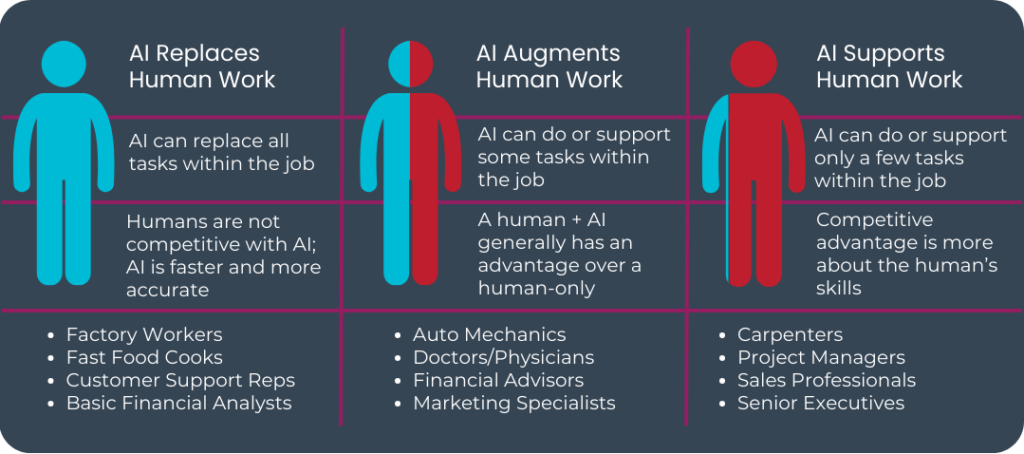Preparing for the Convergence of AI and the Workforce

In the dynamic landscape of technological advancement, the future workforce finds itself on the brink of a revolutionary transformation. Artificial intelligence (AI), automation, and digitalization are swiftly reshaping the very essence of employment, rendering traditional roles obsolete and necessitating a profound shift in skills and expertise. As we stand at this critical juncture, the overarching question prevails: what must organizations do to prepare for the path forward? Read on to learn more or download the full report here.
Understanding AI’s Potential: Benefits, Tradeoffs, and Evolution
The following sections begin to unravel this complex question by analyzing expert findings about AI and the workforce, using the framework of our Disruption Planning Model. Our guidance seeks to help organizations as they think through the second- and third-order impacts of AI and:
- Develop mitigation approaches against potential risks,
- Create strategies to capitalize on opportunities, and
- Understand what actions they can take to influence the future.
Listening to the Experts: A Multifaceted Exchange Uncovers Key Takeaways
To start to understand the implications of the convergence of AI and the workforce, we convened our panel of Experts in Residence (ExR) from diverse fields – government, military, academia, and industry sectors including defense, healthcare, software development, communications, aerospace, life sciences, hospitality, financial services, and entertainment – for an insightful dialogue on the topic. From this multifaceted exchange a set of compelling imperatives emerged that chart a framework to face AI disruption.
Toffler’s Disruption Planning Model: A Framework to Understand AI’s Impact on the Workforce
We next analyzed the ExR dialogue through the framework of our Disruption Planning Model, described in Navigating the Top 9 Future of Work Disruptors. This model serves as a valuable tool to analyze the longer-term disruptions AI may bring and how to prepare for them. We leveraged five of the model’s seven “Planning Dimensions” to delve into various facets of AI’s impact on the future workforce:
- Policies and Practices. The formal and informal rules an organization establishes and practices; both those that are documented and the organizational cultural norms that reflect its values.
- Enterprise Strategy. The big questions about how an organization defines itself related to its products and services, the markets it serves, its differentiators, and its culture.
- People and Team Management. The structures, approaches, and skills of supervisory and management roles that define how people and teams are managed to maximize their productivity and experience.
- Individuals. The skills, behaviors, and beliefs of the people who are providing labor to an organization and how those affect their contributions to the organization.
- Society & Markets. The broad, sweeping changes taking place outside the organization that impact the nature of the workforce and how it interacts with organizations.
AI is a Foundational Technological Advancement
Before sharing our analysis, let us understand why AI has and will continue to have a profound influence on the workforce: AI transcends the status of a mere tool. It stands as a foundational technological advancement, a general-purpose technology with the potential to revolutionize entire industries and society at large. Comprehending this implication is fundamental for effective preparation.
The extensive applicability of AI originates from its versatility across a wide spectrum of applications, catalyzing the enablement of various technologies, in ways that benefit and realize tradeoffs. In terms of benefits, AI holds the promise of diminishing human error, boosting productivity, expediting decision-making processes, and refining pattern identification. However, the concerns surrounding elevated costs, job displacement, ethical considerations, and the conceivable erosion of human creativity must not be disregarded.
AI technology is far from static; it undergoes constant evolution. The emergence of large language models (LLMs) and “generative AI” marks a significant stride forward, broadening AI’s capabilities from narrow, task-specific applications to encompass broader uses and human-like interactions.
Exploring the Multidimensional Impact of AI on the Workforce
To identify the potential impacts of AI on the workforce, it is helpful to compartmentalize how AI could be used across various categories of the enterprise environment. This compartmentalization then helps determine actions to prepare organizations for coming disruptions.
Policies and Practices: Building a Responsible Framework for AI in the Workplace
The integration of AI into the workforce offers immense potential to automate tasks, enhance productivity, and augment human capabilities, it also presents a range of policy and governance challenges that organizations must carefully consider before and during implementation stages. As AI reshapes the workplace, organizations must determine policy and governance implications in complex external and internal landscapes including:
- Data Privacy and Security. AI systems’ accuracy and efficiency rely on the amount of data available. That means organizations and individuals must share data without a clear understanding of how or where it will be used.
- Liability and Accountability. AI’s ability to make autonomous decisions raises questions about liability and accountability in the event of harm. Clear legal frameworks are needed to define who is responsible for AI-driven actions, whether it be the developers, the organizations deploying AI, or the individuals using it.
- Regionalized Regulations. The lack of harmonized local and international AI regulations poses a challenge for companies operating in multiple regulatory domains. Navigating a patchwork of regulations can be complex and costly, potentially hindering innovation and market expansion.
- Risk Management. AI implementation carries inherent risks, including financial, operational, reputational, and legal risks. Organizations must establish comprehensive risk management strategies to identify, assess, and mitigate these risks proactively.
- Decision-Making. AI systems can automate decision-making processes, but striking the right balance between automation and human oversight is crucial. Companies need to determine when AI can make decisions autonomously and when human involvement is essential for ethical considerations, fairness, and accountability.
By addressing these policy and governance challenges proactively, organizations can harness the transformative power of AI while mitigating potential risks and ensuring a responsible AI-powered future of work. This behavior will also allow the workforce to understand and act responsibly as they navigate an AI-enhanced environment.
Enterprise Strategy: Rethinking Market Opportunities, Competitive Advantage, and Team Management
AI-enabled technologies can impact small, medium, and large organizations at an existential and strategic level over the long term. It influences market opportunities, competitive dynamics, and the nature of work. Organizations must carefully consider the following implications of AI to adapt and thrive in this transformative era:
- Market Advantages. AI crafts streamlined operations, fuels data-driven innovation, and expands reach beyond borders, leaving competitors behind. From cost-saving efficiency to personalized products and multilingual support, AI grants an edge to organizations that can efficiently and productively implement these tools.
- Competitive Advantage. AI’s ability to automate and optimize tasks can commoditize certain products and services, potentially eroding competitive advantages. However, AI can empower companies to provide personalized services through human problem-solving creativity and strategic thinking, creating new options for competitive advantage. Either way, understanding the power of AI, applied to enterprise strategy, can create new opportunities.
- Uniquely Human Skills. Despite AI’s advancements, unique human skills remain essential for competitive advantage, especially in areas such as creativity, emotional intelligence, and strategic thinking.
Organizations that are most effective at harnessing the best of AI and the best of their people will create insurmountable competitive advantage gaps with organizations that are slow to adapt. Top performers in nearly every industry, especially among industry leadership, will be defined by these critical characteristics.
People & Team Management: Rethinking Teams and Leadership in the Age of AI
The advent of AI is transforming not only the nature of work but also the dynamics of teams and team management. Organizations must adapt their leadership approaches and reconfigure their teams to effectively harness the power of AI and human collaboration. Organizations will face the need to re-educate and train their employees and managers to match the technology and human needs including:
- Balancing Human versus AI Skills. Organizations that are best able to harness the power of human/machine teaming will be able to create massive productivity, knowledge, and innovation gaps vs. organizations that only rely on human skills.
- Managing Fear of Replacement. Addressing employee concerns about job displacement is crucial for maintaining morale and productivity. Organizations must communicate and educate the organization on AI in the workplace and their role in that future state to tamper expectations and create new opportunities. Leadership must communicate their vision on how humans and AI collaborate rather than let employees think replacement is the ultimate goal.
- Hiring Efficiency. AI can enhance hard skill-based recruitment processes by identifying and adapting roles needed for an AI-enabled workforce. AI can also scale up the very time-intensive and highly subjective interview process. AI-driven interviews and case studies can allow organizations to extensively evaluate a much larger pool of candidates. This tool can also be a significant benefit to employee diversification goals; putting a larger number of candidates through detailed direct evaluation processes frees organizations from relying on proxy measures for competency (e.g., previous employer, title or level, degree or school “brand,” GPA).
- Leadership Training. It is common to talk about the employees directly impacted by AI; however, more thought needs to be put into what managing AI or teams of human/AI collaborators looks like, what skills are required, and what management and leadership traits need to be cultivated. Top-performing organizations will understand and re-train their managers to maximize the performance of AI and human teams.
By understanding the strengths and limitations of AI and human capabilities, organizations will become effective at creating the right team environment to successfully meet strategic goals.
Individuals: Cultivating Uniquely Human Skills in an AI-powered World
AI is not just transforming organizations and teams; it is also profoundly impacting the lives of individuals and their value in an AI-infused world.
- Lifelong Learning. Individuals must stay informed on AI trends and skills to develop transferable skills across industries and interests. Just like “working and playing well with others” has always been a valued trait, “working and collaborating well with AI” will be a valued trait in the future for a large number of jobs. This will require the humility to know what AI can do better than us but also the wisdom to know when we should override “the algorithm” no matter how sophisticated or well-trained it is.
- Uniquely Human Skills and AI Excellence. As the role of AI in the workplace expands, understanding the distinction between uniquely human skills and AI strengths becomes increasingly important. Understanding this difference, as the graphic below illustrates, will allow people to focus their efforts on learning and gaining expertise in those areas that are most likely to stay “human” for the duration of their careers. Striking the right balance between learning AI collaboration and applying human creativity and other uniquely human skills will maximize value to employers.

- Credentialing You and Your AI. Today, AI is generally viewed as belonging to the employer and being used by the employee. However, like all new technologies, cost curves will drop, and AI will become a consumer product. Imagine your personal AI training on your data and behavior as you move from job to job. Personal AI will become integrated with individuals’ work, and the distinction between individual skills and AI-assisted skills may become less clear (e.g., is an employer hiring you or you + your AI?). Smaller, verifiable certifications will gain prominence, reflecting specific skills and competencies (of you and your AI) relevant to future roles.
It is important to remember that this future AI-enabled work environment should not be viewed as a binary, but instead a spectrum in which organizations continue to leverage humans and AI to augment the benefits of both and create a more efficient and profitable organization. A successful future workforce embodies individuals who embrace continuous learning, cultivate uniquely human skills, and collaborate with AI tools effectively.
Society & Markets: Considering International Diversity and Ethics
In our interconnected world, AI is not solely a tool for American stakeholders, but instead a powerful tool, with significant contributions from and impact on non-Western nations. Below are key global considerations when it comes to an AI-enabled work environment:
- Data Privacy and Preferences. AI applications must comply with international and local privacy laws and respect individual privacy rights. Variation in laws could create significant advantages or disadvantages to organizations that want to compete globally.
- Acceptable Risk Levels. Societies have different levels of risk tolerance, particularly in the context of autonomous AI systems.
- Cultural Priorities. Cultural values and norms influence the acceptance and adoption of AI technologies.
- AI Literacy and Skills Development. Nations around the world will emphasize AI skills and understanding differently, creating bottlenecks for its implementation worldwide.
- Investing in AI Infrastructure. It is key to provide access to computing resources, data, and training platforms, particularly in underserved regions.
- Monitoring and Mitigating AI-Driven Inequality. Establishing mechanisms to monitor the impact of AI on income disparity and taking corrective measures.
From Disruption to Empowerment: Mapping Your AI Journey through Ecosystem Analysis and Action
The transformative power of AI necessitates proactive action from organizations to prepare for an AI-infused working environment; and having more control over their destiny. By understanding the potential impacts of AI and taking strategic steps, organizations can mitigate risks, capitalize on opportunities, and position themselves for success in the AI-driven world.
Identify and Analyze Potential Changes
By conducting ecosystem-based analyses and weighing short and long-term benefits against tradeoffs, companies can make informed strategic decisions about if and how to implement transformative AI systems.
- Ecosystem-Based Disruption Analysis. Organizations should conduct a comprehensive analysis of the potential disruptions that AI could bring to the broader ecosystem in which they operate including other technological advancements, regulatory changes, and societal shifts.
- Assessing Benefits and Tradeoffs. Organizations should thoroughly evaluate the potential impacts of AI disruptions, considering direct and indirect positive and negative consequences in the immediate and long-term world.
Define Strategies for Risk Mitigation, Opportunity Capture, and Future Influence
Taking a comprehensive, ecosystem view of the environment in which an organization operates will allow it to better understand both direct impacts and the second- and third-order impacts of AI. This understanding informs:
- Risk Mitigation Strategies. Develop strategies to mitigate potential risks associated with AI adoption, including data privacy and security frameworks, ethical guidelines, and workforce development plans.
- Opportunity Capture Strategies. Develop opportunity capture plans to ensure your organization is prepared to implement AI solutions in areas such as worker productivity, innovation, and market growth strategies.
- Future Influence Strategies. By fostering collaboration, contributing to the field, and advocating for responsible application, organizations can become not just users of AI, but architects of a future where it empowers all.
Identify Immediate Strategic Actions to Prepare for the Future
By beginning to formulate strategies around disruption resilience and opportunity capture, then detailing these approaches into executable plans, companies can ready themselves for the next wave of intelligent automation.
- Initiate Actions Today. Even with AI early in the technological capability and adoption curve, it is clearly here to stay, its capabilities and impact are growing quickly, and it will spread to all corners of society. While we cannot predict exactly how it will evolve, it is not hard to see what its critical impacts can be. Preparing for AI needs to start now to build resilience against potential disruptions and seize opportunities as they emerge.
- Create Plans. Translate strategies into concrete action plans with defined timelines, responsibilities, and resource allocations.
By preparing and embracing the disruption, organizations can effectively navigate the AI-powered future, mitigate risks, capitalize on opportunities, and position themselves for sustainable success in the ever-evolving world of AI.
Leveraging Over 25 Years of Analyzing the Future
As a futures-focused strategy consultancy, Toffler Associates has been helping leaders prepare for uncertainty using our Alternate Futures® Scenario Planning since our founding in 1996. This proven approach has been applied within commercial organizations, government agencies, and the Department of Defense to identify potential critical disruptions, develop resilient strategies, and inform immediate actions.
Our unique approach to scenario planning has three key characteristics:
- Customized Scenarios. We create scenarios unique to each organization’s situation to identify specific implications based on their impacts on the ecosystem in which they operate.
- Comprehensive Worlds. We take a broad perspective to identify potential disruptions across society that reveal direct and indirect impacts, which reveal a broader range of opportunities and risks.
- Informs Actions Today. We link scenario responses to formulate lasting strategies and identify specific and immediate actions that can be taken to capitalize on opportunities and mitigate risks.
Scenario planning is a structured approach to prepare for an uncertain future and inform an enduring and resilient strategy. It can easily be integrated into any strategic planning process.
- Categories
- Futures and Foresight
- Workforce of the Future


 About the Authors
About the Authors
